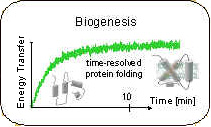
The biogenesis of LHCII is rather complex. The apoprotein is coded for in the nucleus and, therefore, is post-translationally transported into the plastid and then inserted into the thylakoid membrane. This process has been thoroughly studied by a large number of groups. Even so, there are some quite simple questions still entirely open. (1) Where and how are the pigments bound to their apoprotein? (2) How are pigment binding and protein folding coordinated with one another?
In time-resolved measurements of LHCII self-organisation we have shown that pigment binding is a prerequisite for successful protein folding and that chlorophyll a binding precedes the binding of chlorophyll b. EPR spectroscopy is a promising tool to dissect protein folding, too, into individual steps during LHCII assembly (Ref.: Horn & Paulsen, 2004; Hobe et al., 2006; Horn et al., 2007; Dockter et al., 2009; Fehr et al., 2016).